2006 LEXUS LS430 ESP
[x] Cancel search: ESPPage 14 of 419
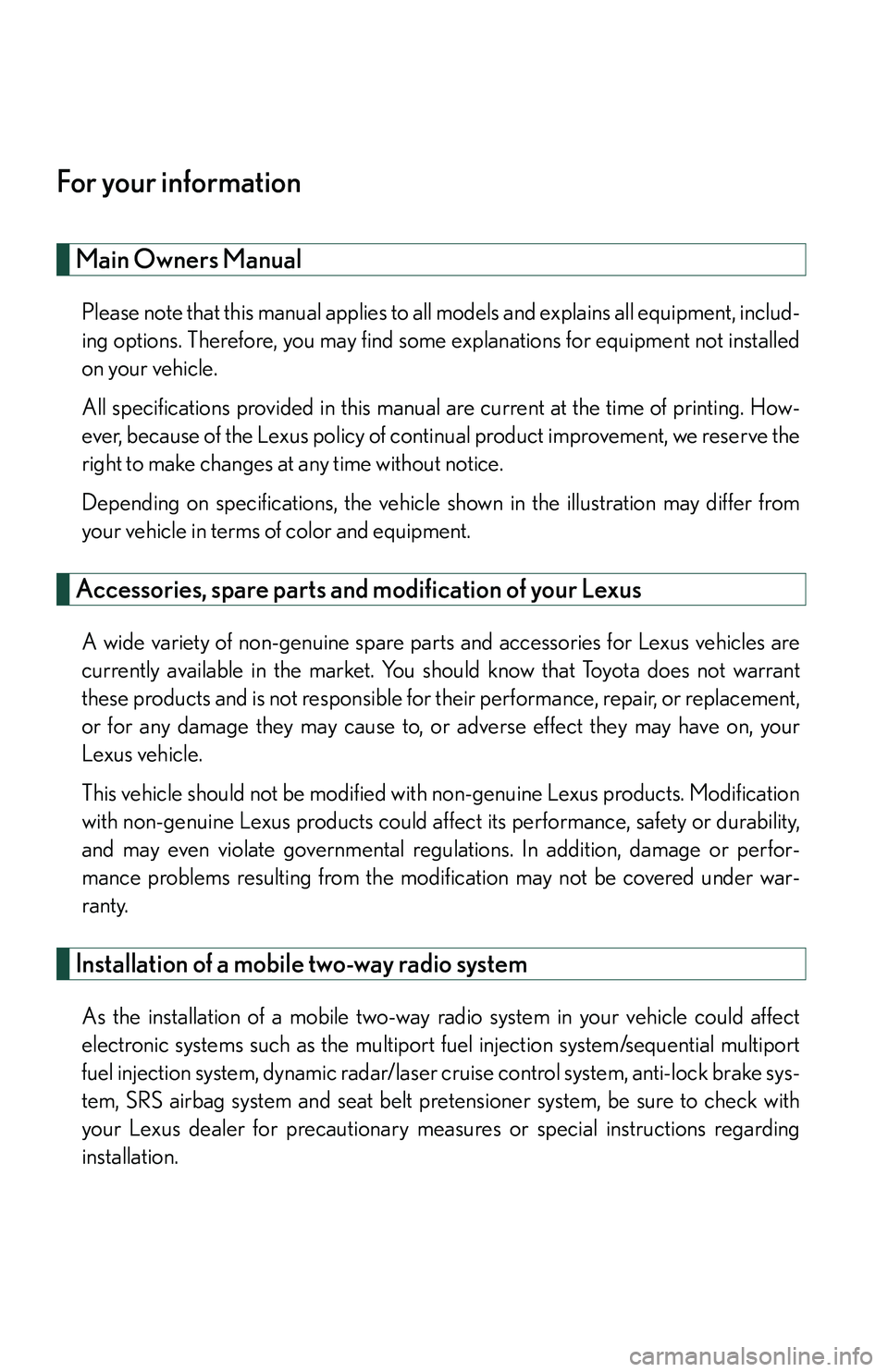
For your information
Main Owners Manual
Please note that this manual applies to all models and explains all equipment, includ-
ing options. Therefore, you may find some explanations for equipment not installed
on y
our vehicle.
All specifications provided in this manual are current at the time of printing. How -
ever, because of the Lexus policy of contin ua
l product improvement, we reserve the
right to make changes at any time without notice.
Depending on specifications, the vehicle show n in
the illustration may differ from
your vehicle in terms of color and equipment.
Accessories, spare parts and modification of your Lexus
A wide variety of non-genuine spare parts and accessories for Lexus vehicles are
currently available in the market. You should know that Toyota does not warrant
these products and is not responsible for their performance, repair, or replacement,
or for any damage they may cause to, or adverse effect they may have on, your
Lexus vehicle.
This vehicle should not be modified with non-genuine Lexus products. Modification
with
non-genuine Lexus products could affect its performance, safety or durability,
and may even violate governmental regula tions. In addition, damage or perfor-
mance problems resulting from the modi fication may not be
covered under war-
ranty.
Installation of a mobile two-way radio system
As the installation of a mobile two-way ra dio system in your vehicle could affect
electronic systems such as the multiport fuel injection system/sequential multiport
fuel injection system, dynamic radar/laser cruise control system, anti-lock brake sys -
tem, SRS airbag system and seat belt pret ensio
ner system, be sure to check with
your Lexus dealer for precautionary measures or special instructions regarding
installation.
Page 27 of 419
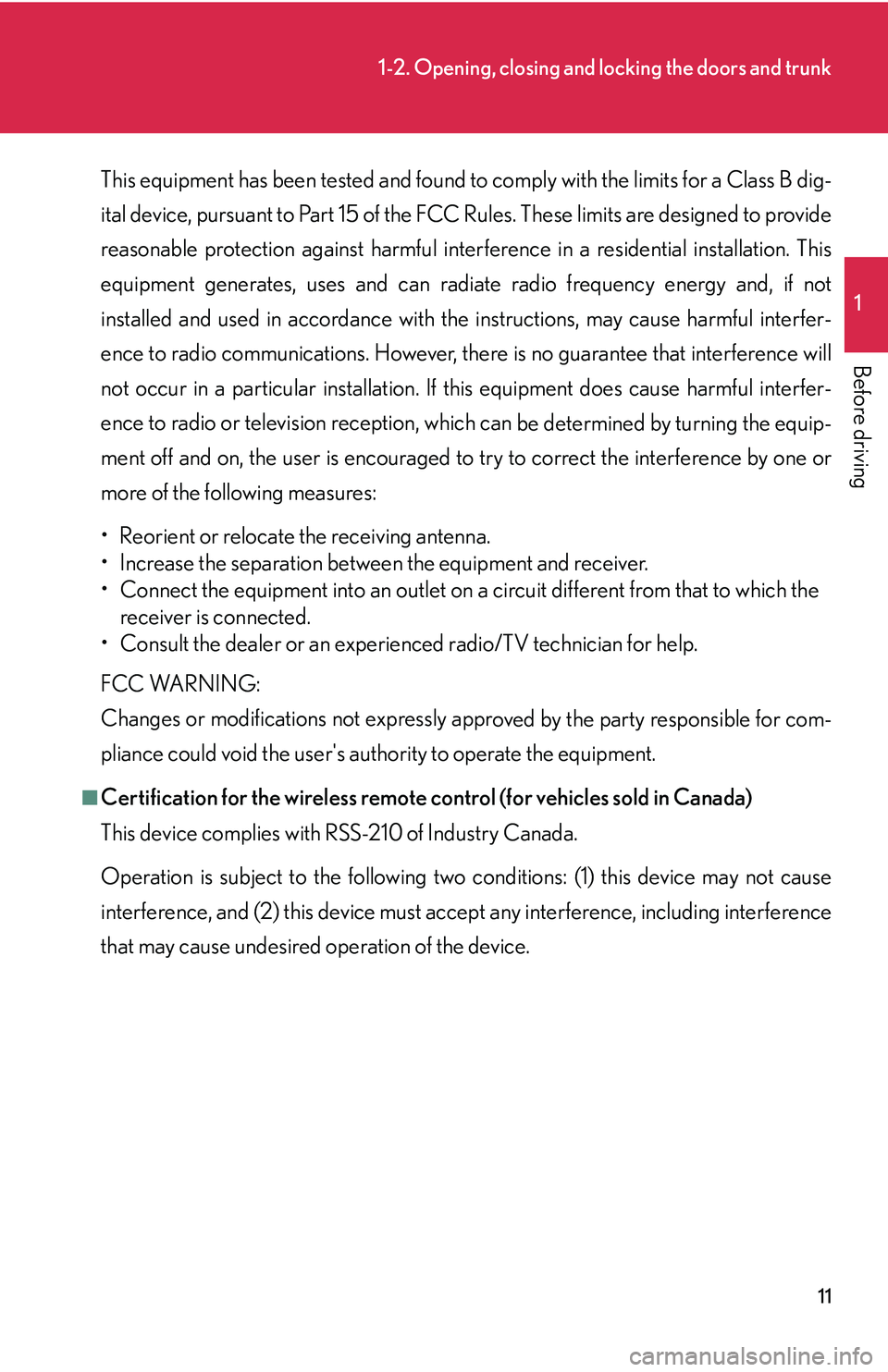
11
1-2. Opening, closing and locking the doors and trunk
1
Before driving
This equipment has been tested and found to comply with the limits for a Class B dig-
ital device, pursuant to Part 15 of the FCC Rules. These limits are designed to provide
r
easonable protection against harmful interference in a residential installation. This
equipment generates, uses and can radi ate radio frequency energy and, if not
installed and used in accordance with th e instructions, may cause harmful interfer -
ence to radio communications. However, there is no guarantee that interference will
n
ot occur in a particular installation. If this equipment does cause harmful interfer -
ence to radio or television reception, wh ich can
be determined by turning the equip-
ment off and on, the user is encouraged to t
ry to correct the interference by one or
more of the following measures:
• Reorient or relocate the
receiving antenna.
• Increase the separation between the equipment and receiver.
• Connect the equipment into an ou
tlet on a circuit different from that to which the
receiver is connected.
• Consult the dealer or an experien ced radi
o/TV technician for help.
FCC WARNING:
Changes or modifications not expressly ap pr
oved by the party responsible for com-
pliance could void the user's authority to operate the equipment.
■Certification for the wireless remote control (for vehicles sold in Canada)
This device complies with RSS-210 of Industry Canada.
Operation is subject to the following two conditions: (1) this device may not cause
inte
rference, and (2) this device must accep t any interference, including interference
that may cause undesired operation of the device.
Page 30 of 419
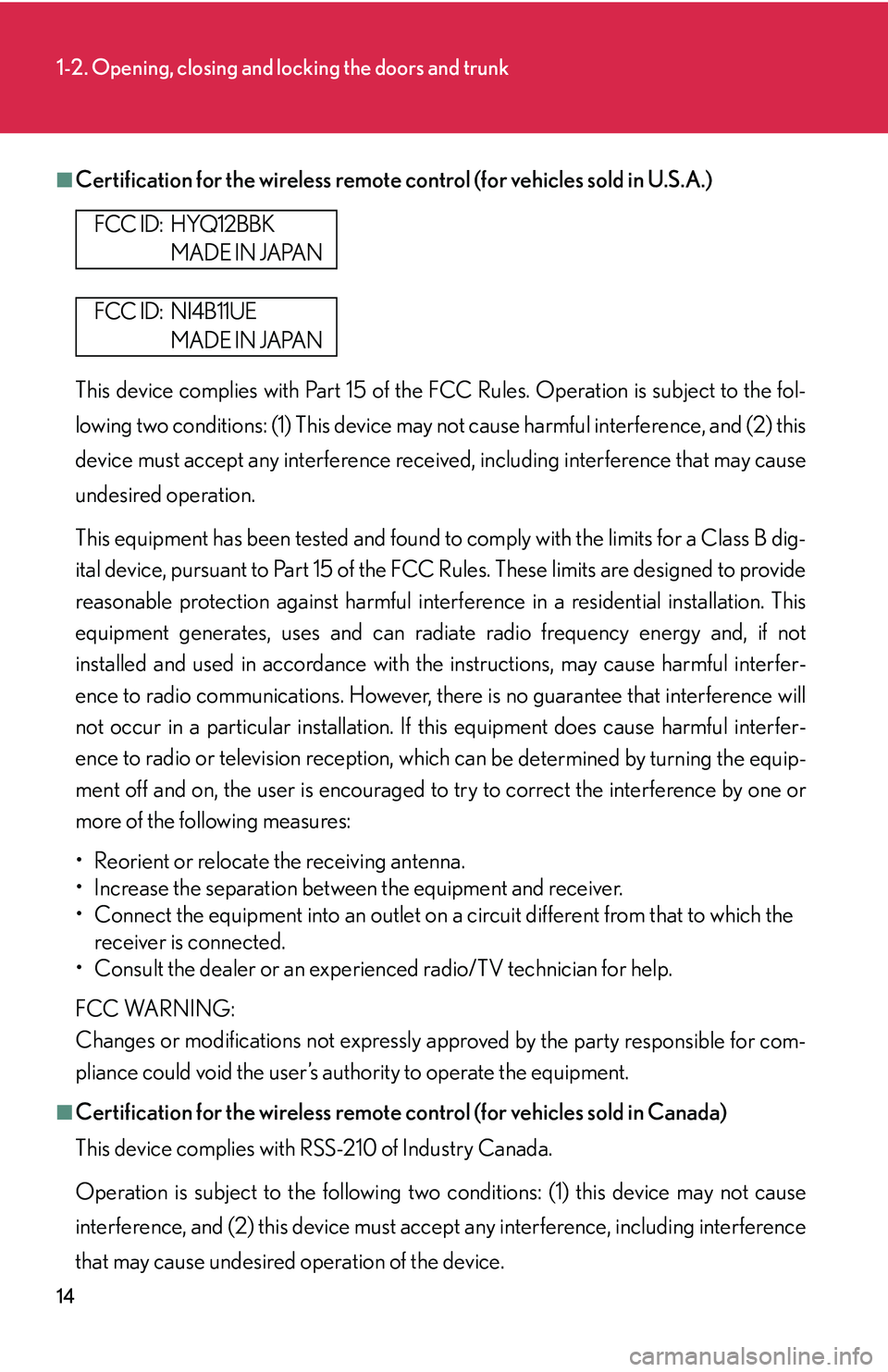
14
1-2. Opening, closing and locking the doors and trunk
■Certification for the wireless remote control (for vehicles sold in U.S.A.)
This device complies with Part 15 of the FCC Rules. Operation is subject to the fol-
lowing two conditions: (1) This device may not cause harmful interference, and (2) this
de
vice must accept any interference receiv ed, including interference that may cause
undesired operation.
This equipment has been tested and found to comply with the limits for a Class B dig -
ital device, pursuant to Part 15 of the FCC Rules. These limits are designed to provide
r
easonable protection against harmful interf erence in a residential installation. This
equipment generates, uses and can radi ate radio frequency energy and, if not
installed and used in accordance with th e instructions, may cause harmful interfer -
ence to radio communications. However, there is no guarantee that interference will
n
ot occur in a particular installation. If this equipment does cause harmful interfer -
ence to radio or television reception, wh ich can
be determined by turning the equip -
ment off and on, the user is encouraged to t
ry to correct the interference by one or
more of the following measures:
• Reorient or relocate the receiving antenna.
• Increase the separation between the equipment and receiver.
• Connect the equipment into an outlet on
a circuit different from that to which the
receiver is connected.
• Consult the dealer or an experien ced radio
/TV technician for help.
FCC WARNING:
Changes or modifications not expressly ap pr
oved by the party responsible for com-
pliance could void the user’s authority to operate the equipment.
■Certification for the wireless remote control (for vehicles sold in Canada)
This device complies with RSS-210 of Industry Canada.
Operation is subject to the following two conditions: (1) this device may not cause
inte
rference, and (2) this device must accep t any interference, including interference
that may cause undesired operation of the device.
FCC ID: HYQ12BBK
MADE IN JAPAN
FCC ID: NI4B11UE
MADE IN JAPAN
Page 82 of 419
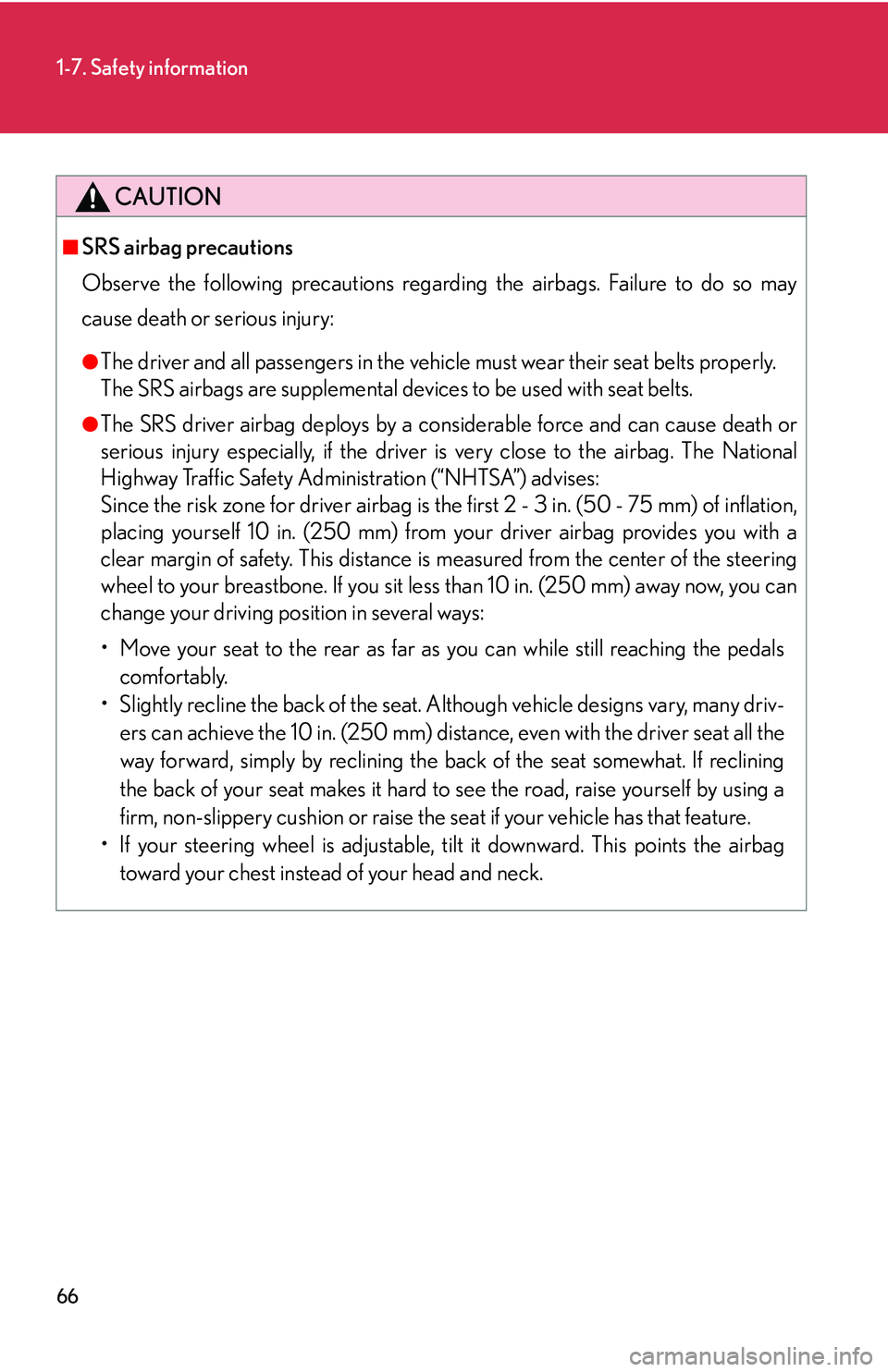
66
1-7. Safety information
CAUTION
■SRS airbag precautions
Observe the following precautions regarding the airbags. Failure to do so may
ca
use death or serious injury:
●The driver and all passengers in the vehicle must wear their seat belts properly.
The SRS airbags are supplemental devices to be used with seat belts.
●The SRS driver airbag deploys by a cons iderable force and can cause death or
serious injury especially, if the driver is very close to the airbag. The National
Highway Traffic Safety Administration (“NHTSA”) advises:
Since the risk zone for driver airbag is th e fi
rst 2 - 3 in. (50 - 75 mm) of inflation,
placing yourself 10 in. (250 mm) from your driver airbag provides you with a
clear margin of safety. This distance is measured from the center of the steering
wheel to your breastbone. If you sit less than 10 in. (250 mm) away now, you can
change your driving position in several ways:
• Move your seat to the rear as far as you can while still reaching the pedals
co
mfortably.
• Slightly recline the back of the seat. Alt
hough vehicle designs vary, many driv-
ers can achieve the 10 in. (250 mm) distance, even with the driver seat all the
w
ay forward, simply by reclining the back of the seat somewhat. If reclining
the back of your seat makes it hard to see the road, raise yourself by using a
firm, non-slippery cushion or raise the seat if your vehicle has that feature.
• If your steering wheel is adjustable, ti lt it do
wnward. This points the airbag
toward your chest instead of your head and neck.
Page 83 of 419
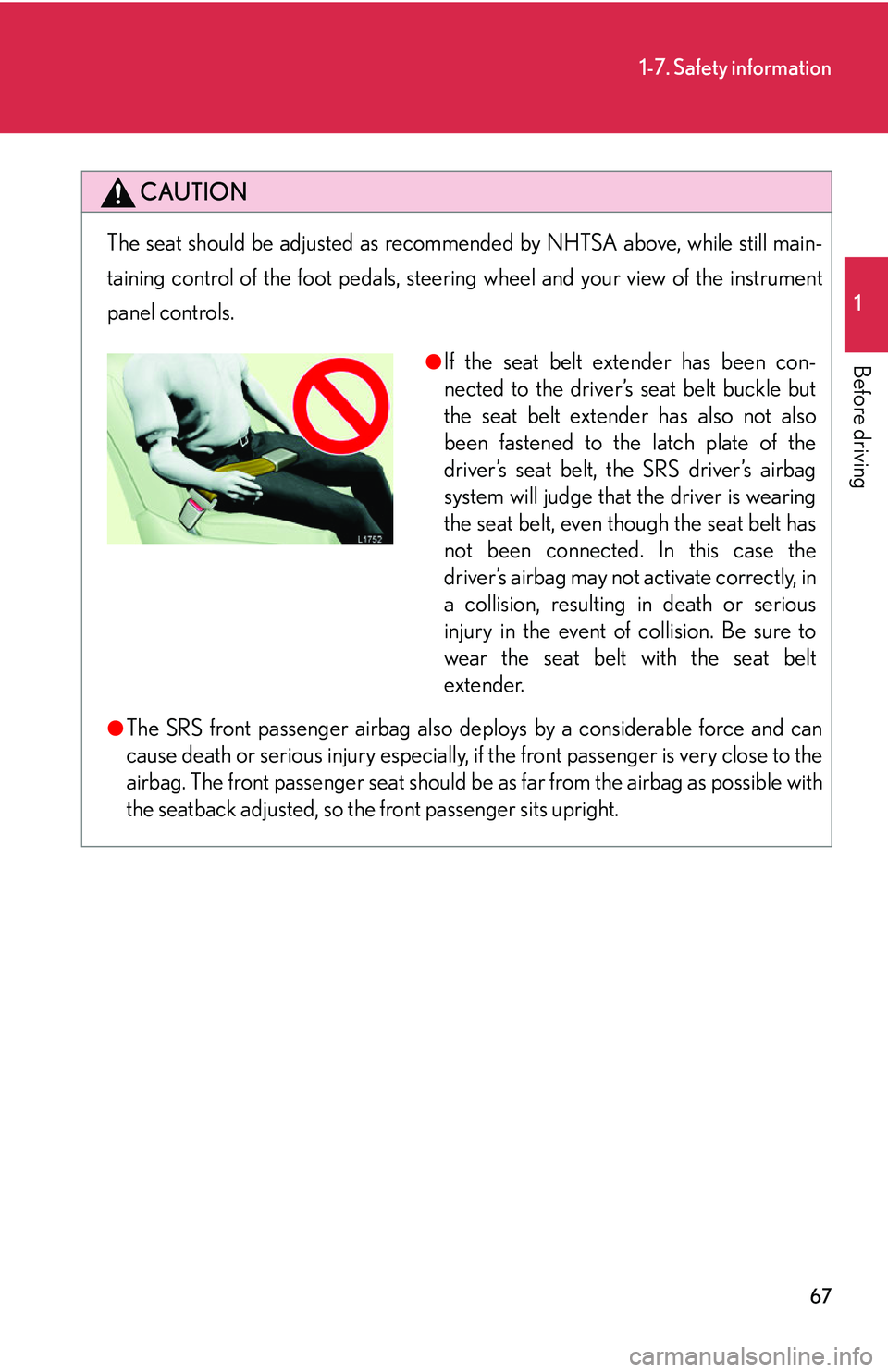
67
1-7. Safety information
1
Before driving
CAUTION
The seat should be adjusted as recommended by NHTSA above, while still main-
taining control of the foot pedals, steerin g
wheel and your view of the instrument
panel controls.
●The SRS front passenger airbag also de ploys by a considerable force and can
cause death or serious injury especially, if the front passenger is very close to the
airbag. The front passenger seat should be as far from the airbag as possible with
the seatback adjusted, so the front passenger sits upright.
●If the seat belt extender has been con-
nected to the driver’s seat belt buckle but
the seat belt extender has also not also
been fastened to the latch plate of the
driver’s seat belt, the SRS driver’s airbag
system will judge that the driver is wearing
the seat belt, even though the seat belt has
not been connected. In this case the
driver’s airbag may not activate correctly, in
a collision, resulting in death or serious
injury in the event of collision. Be sure to
wear the seat belt with the seat belt
extender.
Page 150 of 419

134
2-4. Using other driving systems
■Certifications for the millimeter wave radar laser sensor/ laser radar sensor
(U.S.A.)
●Millimeter wave radar sensor
FCC WARNING:
Changes or modifications not expressly approved by the party responsible for
com
pliance could void the user’s authority to operate the equipment.
FCC RF exposure information:
This device complies with the FCC RF exposure requirements.
●Laser radar sensor
This product is a class I laser product complied with 21 C.F.R part 1040.10 and
10
40.11.
■Certifications for the millimeter wave radar laser sensor/ laser radar sensor
(Canada)
Millimeter wave radar sensor
Operation is subject to the following two conditions;
1. this device may not c
ause interference, and
2. this device must accept any interference r
eceived, including interference that
may cause undesired operation of the device.
■If the master warning light comes on and a warning message appears on the
multi-information display
If a system malfunction occurs when the dyn
amic radar/laser cruise control is on or
in the “RADAR READY” mode, the master warning light comes on, the “CRUISE”
indicator light flashes, a warning tone so unds, and “Check Cruise System” is dis-
played. ( P.334 )
Page 154 of 419
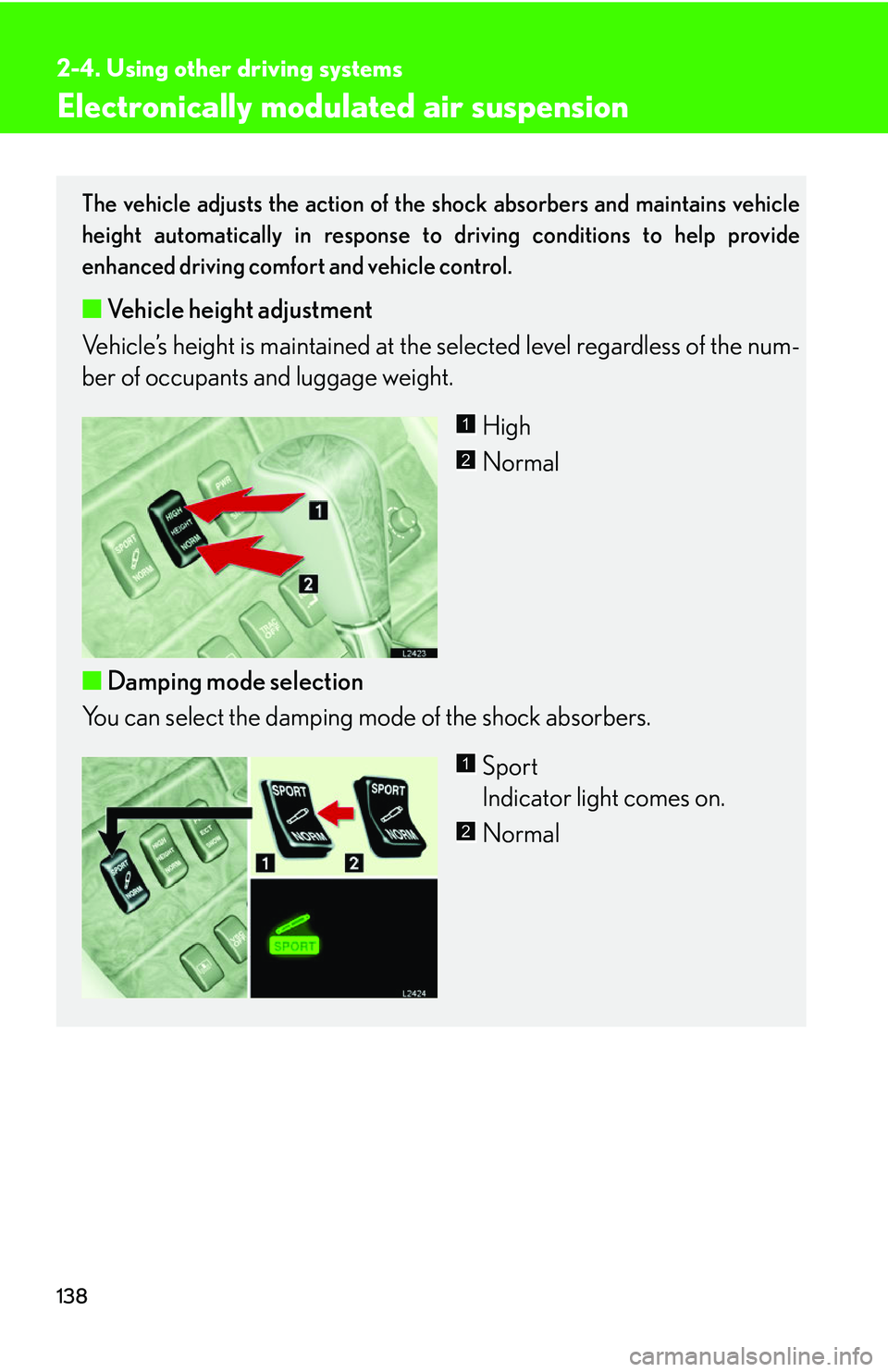
138
2-4. Using other driving systems
Electronically modulated air suspension
The vehicle adjusts the action of the shock absorbers and maintains vehicle
height automatically in response to driving conditions to help provide
enhanced driving comfort and vehicle control.
■ Vehicle height adjustment
Vehicle’s height is maintained at the se lected le
vel regardless of the num-
ber of occupants and luggage weight.
High
Normal
■ D
amping mode selection
You can select the damping mo de of the shock absorbers.
Sport
Indicator light comes on.
Normal
1
2
1
2
Page 173 of 419

157
2-5. Driving information
2
When driving
• As stopping distance is increased when towing a trailer, vehicle-to-
vehicle distance should be increas ed. For each 10 mph (16 km/h) of
speed, allow at least one vehicle and trailer length.
• Avoid sudden braking as you may sk id, r
esulting in jackknifing and loss
of control. This is especially true on wet or slippery surfaces.
• Avoid jerky starts or sudden acceleration.
• Avoid jerky steering and sharp turn s, and slo
w down before making a
turn.
• Note that when making a turn, the tr ailer wheels will be closer than the
v
ehicle wheels to the inside of th e turn. Compensate by making a
larger than normal turning radius.
• Crosswinds and rough roads will ad v
ersely affect handling of your
vehicle and trailer, causing sway. Peri odically check the rear to prepare
for being passed by large trucks or buses, which may cause your vehi-
cle and trailer to sway. If s
waying occurs, firmly grip the steering wheel,
reduce speed immediately but gradually, and steer straight ahead.
Never increase speed. If you make no extreme correction with the
steering or brakes, your vehi cle and trailer will stabilize.
• Take care when passing other vehicl es. P
assing requires considerable
distance. After passing a vehicle, do not forget the length of your
trailer, and be sure you have plenty of room before changing lanes.
• In order to maintain efficient engine br
aking and electrical charging
performance, do not use overdrive. Transmission shift range position
must be in “4”, in the “S” mode.
• Due to the added load of the traile r
, your vehicle’s engine may overheat
on hot days (at temperatures over 85°F [30°C]) when driving up a
long or steep grade. If the engine coolant temperature gauge indicates
overheating, immediately turn off the air conditioning (if in use), pull
your vehicle off the road and stop in a safe spot. See “If your vehicle
overheats” ( P.359 ).